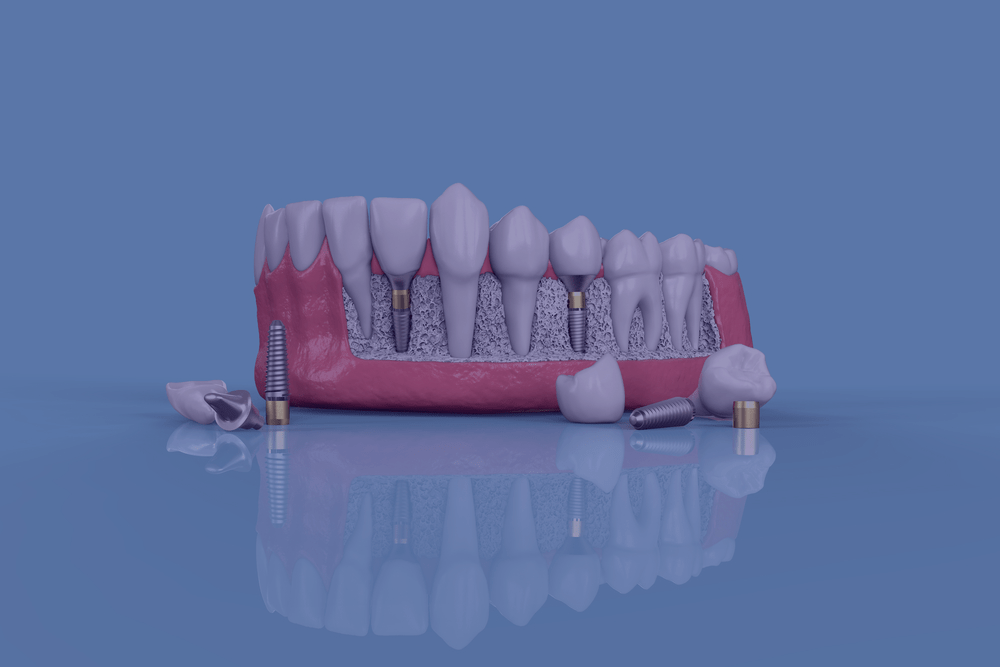
Dental implants
Dental implants and detailed steps
Dental implants It is done by establishing metal implants in the place of missing or decayed teeth that have been extracted or damaged as a result of a bacterial infection in the gum tissue surrounding the tooth or molar.
The reasons for dental implants, the advantages of the dental implant process, the different types of implants, and the detailed steps of the dental implant process before, after, and during the procedure.
Dental implants
Dental implants It is a surgery in which the roots of the natural teeth are replaced with metal braces. Implants are an alternative to dentures and bridges that were made for the teeth. They are a very practical option in use.
The possibility of performing dental implants depends on the condition of the jaw bone and the type of component that will be implanted.
Reasons for dental implants
There are many reasons why you should go to dental implants or encourage dental implants, as follows:
- One or more missing teeth.
- The patient wants to improve his way of speaking, which was affected by the loss of the tooth.
- The person is unable or unwilling to wear dentures.
- The patient has the determination and will to dedicate several months to the operation and treatment in order to achieve a better appearance.
- The patient has a fully developed jawbone and healthy gum tissue.
- The person does not have health conditions that affect bone healing.
The importance of dental implants
The primary goal of dental implants is to replace a missing tooth. There are several points that explain the importance of dental implants, as follows:
- Dental implants can help stabilize partial dentures and are an alternative to removable dentures.
- Small implants play a very important role in treating some orthodontic conditions and in securing the elastics used to move teeth.
- Complete dentures with implants are considered unique because they combine both types of dentures, being more stable and relatively less expensive.
- Implants are used as a complete replacement for dentures and are more aesthetically pleasing and stable than traditional or removable dentures.
Types of dental implants
There are several types of dental implants, which are explained in the following points:
intraosseous implant
This type of dental implant is the most commonly used type in dental implant operations due to its suitability for most patients, but the patient must have:
There is an adequate amount of bone for the dental implant to integrate and bond with.
bone grafting
This type is an alternative to the intraosseous type of dental implants and is used when there is not enough bone for the previous type of dental implants.
This occurs when the patient refuses to use artificial bone to increase the density of the jawbone or the area where the implant will be placed. The implant relies on the bone apex, not inside the bone, and must be covered by the gums to heal around it.
Advantages of dental implants
There are many advantages to dental implants, which are as follows:
- Dental implants give the mouth its beautiful appearance again, as their shape mimics the shape of natural teeth.
- Dental implants are stable and fuse with the bone, unlike dentures, which are bonded.
- The patient's ability to speak, eat, and pronounce words correctly is greatly improved by replacing missing teeth with fixed implants.
- Restore the patient's confidence and ability to smile and have a beautiful appearance.
- The teeth adjacent to the implant are not affected as they maintain the health of the tissues and gums.
- Dental implants are long-lasting and can last a lifetime if you maintain a healthy eating and dental hygiene regimen.
- Dental implants preserve jawbone and prevent its erosion caused by tooth loss.
Contraindications for dental implants
There are some people who are not recommended to have dental implants, and they are as follows:
- Some heart patients with artificial valves or recent heart attacks.
- Patients with active cancer or who have received high doses of radiation therapy to the head area.
- People with immune diseases and some mental disorders.
- Some bone diseases, such as osteomalacia, brittle bone, or Paget's disease, make it difficult for bone to grow on the implant or implant in general, because it depends on knowing the bone density.
- Some cases require a doctor's evaluation to ensure the possibility of dental implants, such as: diabetics, pregnant women, the elderly, and smokers.
Steps before dental implant surgery
There are several steps that must be followed before starting the dental implant process, as follows:
- You will agree with your doctor whether you will perform the dental implant procedure using local or general anesthesia.
- The necessary examinations must be performed. In some cases, the doctor may request a panoramic dental x-ray to better diagnose the problem. These x-rays provide a better visualization than a regular examination.
- Preoperative blood clotting tests are required for people with blood clotting disorders who are considered at increased risk of bleeding.
- The specialist doctor will prescribe some necessary medications before starting the dental implant procedure. These medications are antibiotics to protect against infections and immune deficiency.
- A series of preliminary tests must be performed to assess the gums' receptivity to the implant and construct a tooth that is closer in color and texture to the original tooth.
Dental implant procedure
When performing a dental implant procedure, the following steps are followed:
- The patient is anesthetized by injection, choosing local or general anesthesia according to the agreement between him and the doctor.
- The dental implant process begins by inserting metal screws into the jawbone.
Reconstruction procedures are initiated by taking measurements and creating appropriate implants, and a waiting period of at least 6 weeks is required.
Until the tissues around the implanted teeth or molars heal, and then the final teeth are installed.
Post-dental implant stage
After completing the dental implant procedure Several things should be noted, as follows:
- The patient should avoid drinking or eating for two hours after surgery and until the effects of anesthesia wear off.
- Painkillers are used as needed to avoid any pain felt in the area where the metal implants were placed, especially on the first day.
- To achieve the best results from the procedure, you must take care of your teeth and gums by regularly cleaning them with a soft brush and using mouthwash.
- If you experience any symptoms such as fever, bleeding, or local discharge from the mouth, consult your doctor immediately.
Here we have reached the end of the article on dental implants. We have learned the reasons for implanting them, the different types of dental implants, and explained many of their advantages and disadvantages.
Explaining the cases of some people who are not recommended to have dental implants, and the steps of the procedure before, during and after, and explaining them in detail.
Click here to know the branches
in Novello Clinic We care about beauty
We are happy to contact you
We welcome all your inquiries, suggestions, and complaints.
Novello Clinics
First class services
Our services are integrated with the latest technologies to take care of our customers.










 AR
AR